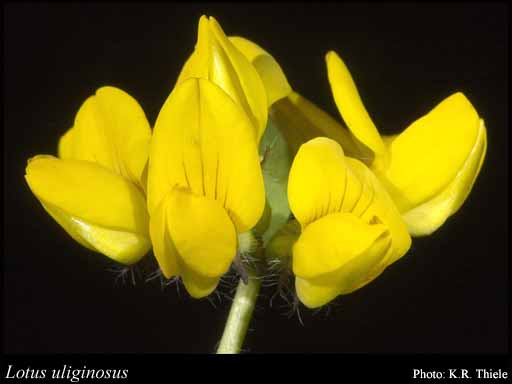- Reference
- Bot.Handb. 2:412-413 (1796)
- Conservation Code
- Not threatened
- Naturalised Status
- Alien to Western Australia
- Name Status
- Current
Erect or ascending perennial, herb, 0.1-0.5 m high. Fl. yellow, Nov to Dec or Jan to Mar. Grey sandy loam, mud, black sand, clay loam. Swamps, creeklines, disturbed & cultivated areas, road verges.







Scientific Description
Prostrate,spreading or scrambling, herb. Stems terete, not spiny, glabrous; pustules or glands absent. Leaves or phylloclades clearly present, alternate, continuous with stem, 10-40 mm long, glabrous, flat with flat margins; margins entire; tubercles absent, leaflets 5, palmately arranged, terminal leaflet absent, sessile; pustules or glands absent. Stipules apparently absent even from the youngest leaves or present but early deciduous ( only visible on youngest leaves ). Pedicel present, 0.5-1 mm long, hairy. Bracteoles present and persistent. Calyx 7-8 mm long, not accrescent, hairy, with simple hairs, ribless; pustules or glands absent. Corolla 11-15 mm long, uniformly coloured, yellow; standard 12-13 mm long, glabrous, not auriculate, wings 11-12.4 mm long, auriculate, keel 12-14 mm long, not beaked, not auriculate, glabrous. Stamens ten, at two different levels (filaments alternately long and short); filaments united in an open sheath with one free stamen, 9-10.5 mm long. Ovary sessile or subsessile, glabrous; style 12.3-15 mm long, glabrous, not bearded, terete. Fruit dehiscent (a pod or follicle), 20-30 mm long, 1.5-2 mm wide, sessile or subsessile, not constricted between the seeds, round in cross-section, glabrous, not beaked. Flowers in January, February, March, November and December. Occurs in the South-West Botanical Province, in the Avon Wheatbelt, Jarrah Forest, Warren and Swan Coastal Plain IBRA regions.
Distribution
- IBRA Regions
- Avon Wheatbelt, Jarrah Forest, Swan Coastal Plain, Warren.
- IBRA Subregions
- Katanning, Northern Jarrah Forest, Perth, Southern Jarrah Forest, Warren.
- Local Government Areas (LGAs)
- Albany, Augusta Margaret River, Bayswater, Bridgetown-Greenbushes, Busselton, Cockburn, Denmark, Donnybrook-Balingup, Kalamunda, Manjimup, Narrogin, Perth, Plantagenet, Serpentine-Jarrahdale.
Management Notes (for the Swan NRM Region)
Alternative Names. Greater Bird's-foot Trefoil, Big Trefoil.
General Biology. Growth form. Herb. Life form. Perennial. Reproduction. Seed, rhizomes. Dispersal. Water, soil. Fire response. Fire is unusual in its habitat, however plants survive and resprout from rhizomes.
Notes. Weed of highly disturbed areas. Naturalised in the US and Australia. Develops extensive rhizomes. Tolerant of acidic soils, waterlogging and flooding. Has a low drought and salinity tolerance. Moderately shade tolerant. Has high levels of hard (dormant) seeds. Most germination occurs in autumn during warmer temperatures. Grows throughout spring and autumn but peak growth occurs in summer.
Additional information. Origin. Northern Africa, Europe. History of use/introduction. Animal forage.
Suggested method of management and control. Spot spray Lontrel® at 10 ml/10 L + 25 mL wetting agent. Read the manufacturers' labels and material safety data sheets before using herbicides. For further information consult the Australian Pesticides and Veterinary Medicines Authority to determine the status of permits for your situation or state.
Management Calendar
| Calendar Type | Jan | Feb | Mar | Apr | May | Jun | Jul | Aug | Sep | Oct | Nov | Dec | Comments |
|---|---|---|---|---|---|---|---|---|---|---|---|---|---|
| Germination | Y | Y | Y | ||||||||||
| Active Growth | Y | Y | Y | Y | Y | Y | Y | Y | Y | ||||
| Flowering | Y | Y | Y | Y | Y | ||||||||
| Fruiting | Y | Y | Y | ||||||||||
| Herbicide Treatment | Y | Y | Y | Y | Y |
Legend: Y = Yes, regularly, O = Occasionally, U = Uncertain, referred by others but not confirmed.
References
- Balocchi, L.O., Lopez, C.I. & Pfister B.M. (1999) Physical and germinative characterisation of the seeds of native and naturalised pasture species in southern Chile. II: Anthoxanthum odoratum, Holcus lanatus, Poa pratensis and Lotus uliginosus. Agro Science, 27 (2): 35-47.
- Balocchi, O.A. & Phillips, C.J.C. (1997) The morphology and development of Lotus uliginosus and Trifolium subterraneum under Pinus radiata canopy in southern Chile. Agroforestry Systems, 37 (1): 15-26.
- Brown, K. & Brooks, K. (2002) Bushland Weeds: A Practical Guide to their Management. Environmental Weeds Action Network, Greenwood.
- Cook, B.G., Pengelly, B.C., Brown, S.D., Donnelly, J.L., Eagles, D.A., Franco, M.A., Hanson, J., Mullen, B.F., Partridge, I.J., Peters, M. & Schultze-Kraft, R. (2005) Tropical Forages: an interactive selection tool [CD-ROM] Lotus uliginosus. CSIRO, DPI&F (Qld), CIAT and ILRI, Brisbane, Australia.
- Frame, J. (1998) Lotus uliginosus Schkur. Food and Agriculture Organisation of the UN URL: http://www.fao.org/ag/AGP/agpc/doc/GBASE/data/pf000345.htm - Accessed September 2010.
- Hussey, B.M.J., Keighery, G.J., Dodd, J., Lloyd, S.G. & Cousens, R.D. (2007) Western Weeds. A guide to the weeds of Western Australia. 2nd Edition. The Plant Protection Society of Western Australia, Victoria Park.
- Moore, G., Sanford, P. & Wiley, T. (2006) Perennial pastures for Western Australia, Bulletin 4690. Department of Agriculture and Food, Perth.
- Moore, J.H. & Wheeler, J. (2008) Southern weeds and their control. DAFWA Bulletin 4744.
- USDA, ARS, National Genetic Resources Program (2009) Germplasm Resources Information Network - (GRIN). National Germplasm Resources Laboratory, Beltsville, Maryland. URL: https://npgsweb.ars-grin.gov/gringlobal/taxon/taxonomysimple.aspx - Accessed October 2009.